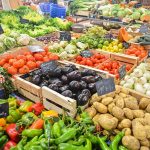Why is something destined for the toilet so important to our health?
Dietary fibre (also known as ‘roughage’ or ‘bulk’) is the indigestible portion of plant foods. It passes relatively unchanged into the large intestine and is broken down (fermented) by gut bacteria. Hence it is called a ‘probiotic’ – promoting the growth and activity of desirable bacteria in the colon – sometimes accompanied by undesirable gas.
Fibre is found in vegetables, fruits, beans, legumes, nuts, seeds and the bran or husk of whole grains. Animal foods do not contain any dietary fibre. For a list of fibre-rich foods click here. Foods high in fibre are packed with vitamins and antioxidants and they add volume to a meal so we need less to feel full. Fibrous foods also require more chewing which means it takes longer to get through the meal. The ‘full’ signal therefore has time to reach the brain before we’ve overshot the mark. Studies consistently show that a fibre-rich diet is associated with reduced risk of diabetes, heart disease, stroke, obesity and gastrointestinal diseases. Emerging research suggests that fibre may also play a role in modulating immune responses and lower the risk of certain cancers and autoimmune disorders. Having said that, please read the warnings in my next two HEBs.
There are two types of fibre and they have different roles in the body: soluble, which dissolves in water, and insoluble, which does not. Most plants contain a mixture of both types of fibre. However it’s important to get your fibre from a variety of plant sources because some foods have more of one type than the other. Soluble and insoluble fibre work together to keep our digestive tract and resident bacteria in optimal health. Both types of fibre bulk up and soften the stool and help prevent constipation and haemorrhoids, provided you also drink adequate amounts of water.
SOLUBLE FIBRE
Soluble fibre absorbs water to form a gel and slows down emptying of the stomach into the duodenum (the first part of the small intestine). This means we feel fuller sooner and for a longer period of time. There is no calorie sensor in our stomach that tells us to stop eating. The brain relies on stretch receptors to send the message that we have consumed enough.
Soluble fibre binds bile acids (made from cholesterol) and carries them out of the body. This means the body has to use up cholesterol to make more bile acids. This is how fibre helps ensure healthy blood cholesterol levels.
INSOLUBLE FIBRE
Insoluble fibre is the structural, woody or stringy component of plants such as celery and asparagus. It is also found in the skin of fruit and vegetables. Peeling foods and blanching almonds reduces their insoluble fibre content.
When food leaves the stomach, insoluble fibre speeds up the passage of food through the rest of the gut. Despite the speeding up, both types of fibre slow down the rate at which sugars are absorbed from the intestine into the bloodstream. This is great news. It means that if you eat a glucose-containing food you get less of a rise in insulin and if you eat a fructose-containing food, your liver can keep up with the influx of fructose and you don’t get the cascade of chemical reactions that cause diabetes and inflammation. Here you have two reasons that eating fruit does not lead to health problems. The fibre in fruit stops you eating too much because you feel fuller sooner and it slows down absorption so your blood sugar doesn’t spike and your liver doesn’t get overwhelmed.
So how much fibre do we need on a daily basis? And can there be too much of a good thing? The next two HEBs answer these questions.


